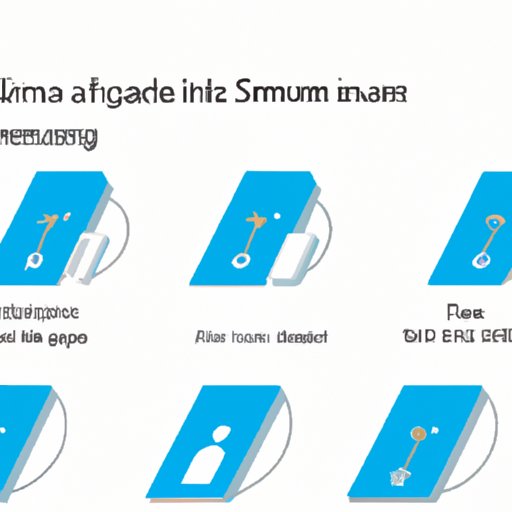
Introduction
With the increasing popularity of eSIM technology, more and more people are looking for ways to transfer from physical SIM to eSIM. This article will provide a step-by-step guide on how to make the switch and the many benefits of doing so.
Step-by-Step Guide
Before you begin the process of transferring from physical SIM to eSIM, it’s important to check that your device and carrier support eSIM technology. Once you have confirmed this, follow these steps:
- Obtain an eSIM QR code from your carrier.
- Go to your device settings and select “Mobile Data” or “Cellular Data.”
- Select “Add Data Plan” and use your device to scan the eSIM QR code.
- Follow the prompts to activate your eSIM.
It’s important to note that the process may vary slightly depending on your device and carrier. Therefore, it’s recommended to consult your device’s user manual or contact your carrier’s customer service for assistance.
Differences between SIM and eSIM
The main difference between a physical SIM and an eSIM is that the former is a physical card that must be inserted into a device, while the latter is an embedded SIM that is built into the device.
eSIM technology allows users to switch between carriers and plans without having to physically change the SIM card. It also enables users to have multiple eSIM profiles on a single device, reducing the need to carry multiple devices for different purposes.
Benefits of eSIM
eSIM technology offers several benefits that physical SIM cards cannot match. These include:
- Convenience: With eSIM, you never have to worry about losing or damaging your physical SIM card.
- Flexibility: Switching between carriers or plans can be done with ease using eSIM technology.
- Cost-effectiveness: eSIM technology can save you money as carriers are starting to offer more competitive eSIM plans.
Real-life examples of how eSIM improves users’ experiences include:
- Business travelers can easily switch between domestic and international carriers without having to purchase a new SIM card every time they travel.
- Active people who use multiple devices for fitness activities (such as smartwatches and earbuds) can use eSIMs to connect all their devices to the same plan.
Personal Experience
As someone who recently made the switch from physical SIM to eSIM, I can attest to the convenience and flexibility eSIM offers. At first, I was nervous about the process, but I found it to be relatively straightforward and easy to follow. I now have multiple eSIM profiles on my device, allowing me to switch between carriers and plans depending on my needs without having to remove and insert physical SIM cards.
One challenge I faced during the process was making sure my carrier and device were compatible with eSIM technology. I called my carrier’s customer service, and they were able to confirm that my device was compatible and provide me with the necessary QR code to activate my eSIM.
Vendor Comparison
There are many eSIM vendors available, each with unique features and pricing structures. Here are some popular options:
- Google Fi: Offers competitive international plans and works with Google Pixel and other devices.
- Truphone: Offers prepaid plans and works with select devices.
- Ubigi: Offers eSIM plans for select vehicles and connected devices.
It’s important to research and compare different eSIM vendors to find the one that best fits your needs.
Technical Considerations
eSIM technology is still relatively new, and as such, compatibility can vary depending on the device, operating system, and carrier. It’s recommended to consult your device user manual or carrier customer service to confirm compatibility before transferring to eSIM.
If you encounter technical issues during the transfer process, try restarting your device or contacting your carrier’s customer service for assistance.
Preparation Checklist
Before transferring from a physical SIM to an eSIM, make sure to:
- Confirm that your device and carrier support eSIM technology.
- Obtain the necessary eSIM QR code or activation card from your carrier.
- Back up any important data on your device.
- Remove the physical SIM card from your device.
Conclusion
In conclusion, transferring from a physical SIM to an eSIM offers many benefits, including convenience, flexibility, and cost-effectiveness. The process varies depending on your device and carrier, but by following the steps outlined above and consulting your device user manual or carrier customer service, you can make the switch with ease. With many different eSIM vendors available, it’s important to research and compare to find the best fit for your needs.




